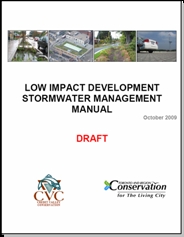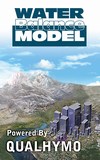Two Ontario Conservation Authorities collaborate to develop "Low Impact Development Stormwater Management Manual"
The Low Impact Development Stormwater Management Manual has been developed by Credit Valley Conservation (CVC) and Toronto and Region Conservation Authority (TRCA) as a tool to help developers, consultants, municipalities and landowners understand and implement more sustainable rainwater/stormwater management planning and design practices in their watersheds.
 “The Manual provides information and direction to assist engineers, ecologists and planners with landscape-based stormwater management planning; and selection, design, construction and monitoring of sustainable stormwater management
“The Manual provides information and direction to assist engineers, ecologists and planners with landscape-based stormwater management planning; and selection, design, construction and monitoring of sustainable stormwater management
practices,” explains Sameer Dhalla, Water Resources Manager in the TRCA's Ecology Divison.
“The manual focus is on guidance regarding the planning and design of structural low impact development practices for rainwater/stormwater management.”
“An updated and improved version of the manual is now available for download on our STEP website –  www.sustainabletechnologies.ca. We are asking for feedback on the latest draft by November 16, 2009 so that we can finalize it by the end of the year.”
www.sustainabletechnologies.ca. We are asking for feedback on the latest draft by November 16, 2009 so that we can finalize it by the end of the year.”
To download a copy of the October 2009 DRAFT from the TRCA website, click on Low Impact Development Stormwater Management Manual.
Manual augments Provincial Manual
“The Manual is intended to augment the Ontario Ministry of the Environment (OMOE) Stormwater Management Planning and Design Manual (2003). The OMOE manual provides design criteria for “conventional” end-of-pipe stormwater management practices such as wet ponds and constructed wetlands but provides only limited information about lot level and conveyance controls,” continues Sameer Dhalla.
“The OMOE manual does, however, emphasize the use of a 'treatment train' approach to reduce the impacts of stormwatercrunoff. A treatment train approach – a combination of lot level, conveyance, and end-of-pipe stormwater management practices – is usually required to meet the multiple objectives of rainwater/stormwater management, which include maintaining the hydrologic cycle, protecting water quality, and preventing increased erosion and flooding.”
“Our LID Manual focuses on a number of lot level and conveyance rainwater management practices that have been used extensively in Europe, the United States,
British Columbia and at demonstration sites in Ontario.”
British Columbia Connection
The LID Manual references several British Columbia guidance documents, and includes this 2005 quote from Metro Vancouver to provide context: “There is a need for a change in the philosophy of treating runoff from one of stormwater management to rainwater management.”
The TRCA is collaborating with the British Columbia Inter-Governmental Partnership to  encourage Canada-wide use of the Water Balance Model.
encourage Canada-wide use of the Water Balance Model.
“The QUALHYMO hydrology engine developed by Dr. Charles Rowney is the ‘model of choice’ in both Ontario and Alberta. This influenced our decision to integrate it with the Water Balance Model interface to create a pan-Canadian tool for evaluating the effectiveness of green infrastructure practices for rainwater  capture. In British Columbia, green infrastructure is the term of choice,” states Ted van der Gulik, Chair of the BC Inter-Governmental Partnership (and Senior Engineer in the BC Ministry of Agriculture & Lands).
capture. In British Columbia, green infrastructure is the term of choice,” states Ted van der Gulik, Chair of the BC Inter-Governmental Partnership (and Senior Engineer in the BC Ministry of Agriculture & Lands).
“The Water Balance Model interface accepts the user data and prepares it for use by QUALHYMO, and then formats the calculation results into a simple reporting structure. Scenario comparisons that once took hours or even days can now be completed in minutes.”
“We are already seeing that the capability to quickly and efficiently complete and report out results in a standardized format is accelerating changes in land development practices. In British Columbia, we describe this paradigm-shift as The New Business As Usual.”
What is STEP?

The Sustainable Technologies Evaluation Program (STEP) is a multi-agency initiative, led by the Toronto and Region Conservation Authority. The program was developed to provide the data and analytical tools necessary to support broader implementation of sustainable technologies and practices within a Canadian context. Its main objectives are to:
- monitor and evaluate clean water, air and energy technologies;
- assess barriers and opportunities to implementing technologies;
- develop tools, guidelines and policies, and
- promote broader use of effective technologies through research, education and advocacy.
Technologies evaluated under STEP are not limited to physical structures; they may also include preventative measures, implementation protocols, alternative urban site designs, and other innovative practices that help create more sustainable and liveable communities.
The mandate and organizational structure for the water component builds upon experiences from the Stormwater Assessment Monitoring and Performance (SWAMP) program and feedback from various agency and industry representatives. Click here to learn more about the SWAMP program.
Posted October 2009

